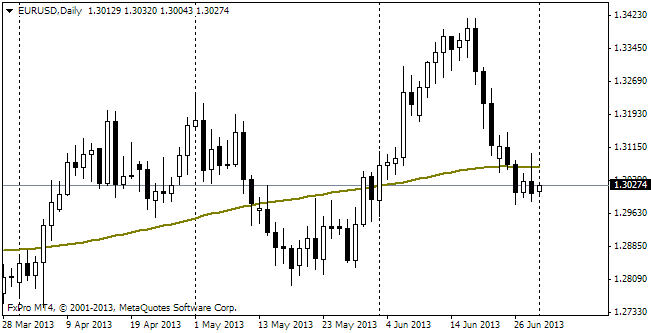EUR/usd
Probably, it is too early to speak about this, but it seems that the euro/dollar has just reversed. In October and December the single currency unsuccessfully tried to break through 1.38 against the dollar. And if there were some grounds for the former, the latter rise took place amid low volumes in the thin holiday market. The main target of such an ascent is to wash out shorts, which usually precedes a real reversal. It's a kind of the bulls' last attack or chasing for stops. Since the beginning of the year the stress has been laid on the rational strategy – to sell the common European currency. Over the last three days the euro was severely pushed down from 1.3800 to 1.3590. Then followed some consolidation. Here the dollar was hurt by the poor employment statistics (growth by 74K against the expected 200). It gave rise to speculations that the Fed wouldn't make another step to taper QE3 at the end of January. Since then we've received a great deal of positive statistics, confirming that the economic recovery is going on. More so, it's even getting faster. So, there is no cause for concern and the January data are nothing more than a one-time drop, aggravated by holidays, cold weather, so fomc's officials are not going to exaggerate their importance. On Friday EURUSD, in our opinion, broke through an important support. It hit 1.3550 and then quickly dropped to 1.3500. It's vital to understand that the movement occurred almost in the absence of good news from the USA. The industrial production failed to meet the expectations, having grown by 0.3% instead of 0.4%. Besides, the UoM Consumer Sentiment instead of growing from 82.5 to 83.4 fell down to 80.4. So, depreciation of the euro/dollar on such news looks quite unnatural. Thus, we expect that the downtrend will continue in the coming days, and may get stronger should 1.3500 be broken. Anyway, today we may see a small pullback, which will allow to sell the euro.

GBP/USD
The British pound got a surprise from retail sales on Friday. In December this indicator made 2.6%, which is the sharpest growth since 1996. Accordingly, the annual growth rate accelerated from 1.8% to 5.3%. Yet, it's a bit doubtful that such perfect figures will be seen again next month. Most likely, it all will turn into a strong correction. Anyway, on Friday this release helped the pound grow by a figure and a half against USD, which actually happened for less than an hour. Also thanks to this release the pound didn't suffer such a strong reversal as the euro does. The pound is a step ahead the euro. And those, who want to sell it, already now can take an opportunity.

USD/JPY
The Japanese yen is still unable to start testing new highs. The bulls fail to overcome the correction, which came with the beginning of the year and threw the pair below 103.00. The best high achieved is 104.90, hit in the middle of the previous week. In the last few hours the pair have faced some purchases, but nevertheless remains below last week's close. From the technical viewpoint there are no reasons for the slowdown in the yen's growth, but actually the dollar is not very popular now, which stops the bulls.

AUD/USD
The relatively poor Chinese statistics made the Aussie hit a fresh three-and-a-half-year low against USD. It is remarkable that the pair's bulls are too weak to continue selling. On the other hand, buyers of the Australian currency need at least some hint at the economic stabilization to start taking active actions. Don't forget that the RBA's head at the end of the year mentioned 0.8500 as an acceptable level for the Australian currency. The only obstacle to this level may be posed by a strong inflation report, which we'll learn on Wednesday.
